#go back to the pachyrhinosaurus
Text
sometimes when playing ark you completely forget about something you’ve read.
I finally build a nice little enclosure for all (I think it’s around this number) 30 dodos. I put a feeding trough in and fill it up. I set everyone to passive flee, wandering, disabled mating.
I take a quick step outside to grab something, come back, look up in horror at all the mating hearts floating above the enclosure. I completely forgot that you can’t turn off mating when they’re wandering, and that they automatically mate when they wander.
so I guess I’m gonna have to deal with that tomorrow (use the resulting eggs to make kibble)
#Emu tries to post#ark#ark survival evolved#this is a lovely game in whyi go looking for a spino which I don’t find#I go down to rest my pteranodon#all the other pteranodons which were carrying the spino trap supplies and narcotics and such are being annoying.#a pachyrhinosaurus walks up to me#much shenanigans in taking her like losing half my narcotics when I forgot to feed them to her and she woke up#because I was too busy watching a pack of terror birds terrorise everything in sight#one is swimming trying to get me#i knock it out#take him#go back to the pachyrhinosaurus#in our way back to base there’s a higher level male#I knock him out after wasting many arrows hitting his head#I go to out the narcotics and food in his inventory#while exiting the inventory a dilo has murdered him#because I set all my tames to passive so they wouldn’t kill him before I knocked him out#so I had to tell them to kill the dilo#but anyway I go home to make saddles and dye them blue and red for the new guys#I think my best name for anything so far would be cowboy the fastest#my gallimimus#she’s wonderful#very good dino to command others from#since I can just yeet myself away at light speed
19 notes
·
View notes
Text
Lokiceratops rangiformis Loewen et al., 2024 (new genus and species)
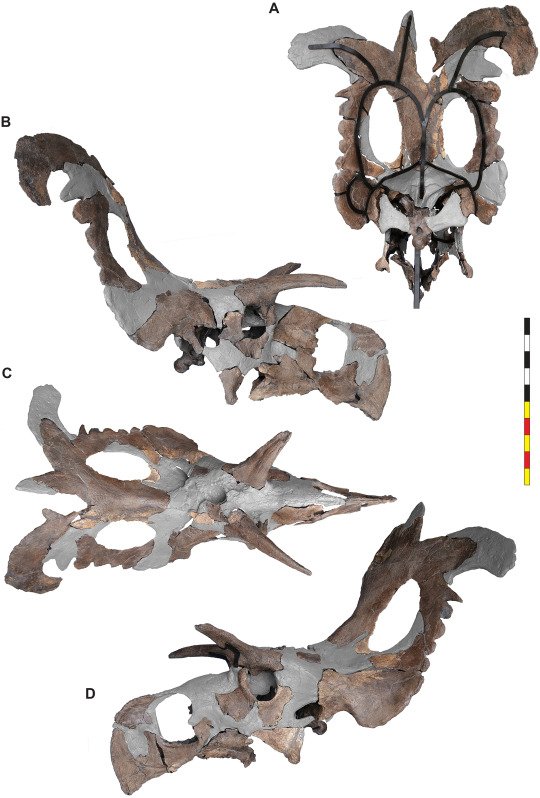
(Reconstructed skull of Lokiceratops rangiformis [scale bar = 1 m], with unpreserved portions in gray, from Loewen et al., 2024)
Meaning of name: Lokiceratops = [Norse deity] Loki's horned face [in Greek]; rangiformis = Rangifer [genus of the extant reindeer]-shaped [in Latin]
Age: Late Cretaceous (Campanian), roughly 78.1 million years ago
Where found: Judith River Formation, Montana, U.S.A.
How much is known: Partial skeleton of one individual, including a partial skull, several vertebrae, and some limb bones.
Notes: Lokiceratops was a centrosaurine cereratopsian, making it a horned dinosaur more closely related to Styracosaurus and Pachyrhinosaurus than to Triceratops. It is one of the largest known centrosaurines, with its skull alone being nearly 2 m long.
The skull of Lokiceratops was highly distinctive. A pair of very large, curved horns at the back of its frill pointed out to the sides. Furthermore, a pair of smaller horns closer to the center of the frill was asymmetrical, with one horn being larger than the other. Asymmetrical head ornamentation is also seen in the antlers of reindeer, hence the species name "rangiformis".
Lokiceratops is known from approximately the same time and location as three other centrosaurines, Albertaceratops, Medusaceratops, and Wendiceratops. Despite their diversity, all centrosaurines discovered so far are only known from very narrow ranges in both time and space. This may suggest that these horned dinosaurs diversified rapidly into numerous forms differentiated primarily by display features such as the shape of their horns and frills, with each species lasting only a short time in a small geographic region before evolving into new species or going extinct.
Reference: Loewen, M.A., J.J.W. Sertich, S. Sampson, J.K. O’Connor, S. Carpenter, B. Sisson, A. Øhlenschlæger, A.A. Farke, P.J. Makovicky, N. Longrich, and D.C. Evans. 2024. Lokiceratops rangiformis gen. et sp. nov. (Ceratopsidae: Centrosaurinae) from the Campanian Judith River Formation of Montana reveals rapid regional radiations and extreme endemism within centrosaurine dinosaurs. PeerJ 12: e17224. doi: 10.7717/peerj.17224
412 notes
·
View notes
Text
Ok! I watched Chaos Theory! I have a lot of thoughts! There were things I liked a lot and things I wasn’t a fan of. I generally liked it but came away slightly underwhelmed. If you haven’t watched it yet please go do so!!! Support the show and the wonderful crew that put it together!!!
SPOILERS BELOW THE CUT
WHAT I LIKED:
-MATEO!!! I literally loved him so much. A fantastic, simple character that doesn’t overstay his welcome or detract from our main characters. Great motivations and realistic backstory. Yeah. I really liked him. Yeah.
-Yasammy! Obviously they were amazing. They got to be cute and bubbly and gay but also their argument was so real and believable. Neither one of them is completely in the wrong. They are just two flawed people who’ve been through more than they can handle on their own. They need each other but not always in the way they might think. They were such a highlight this season. Can’t wait for more of them.
-This whole show just feels like a dramatic step up in visual storytelling from CC. The sets are beautiful and intricate, the lighting and textures are fantastic, and the directing is just really great. There are some really creative shots and transitions, and overall it just feels like more confident directing and storyboarding all around. (I specifically remember episode 7 being really great visually. Super fun stuff.)
-All the dinosaur action was great. Like next level shit. The way they keep finding creative ways to use these animals for action and suspense is very impressive. The raptors are genuinely scary. The Allosaurus and Pachyrhinosaurus were personal favs.
-Unlike Dominion, they actually showed what living in a world with dinosaurs is like- how people are adjusting to this new way of life, adapting to the presence of these animals, and keeping themselves safe. Totally what I wanted to see from Dominion, and Chaos Theory did it better within a single episode.
-There was some very well crafted suspense throughout this season. The mystery does a great job of constantly keeping you pulled in. Every time a question is answered, five more are asked.
-The darker tone is definitely welcome. The characters are older and they’ve experienced a terrible loss. The weight of the new world weighs on them and the audience in a very tangible way.
-This one isn’t really constructive but like. I just love Darius so much. He’s so perfect.
WHAT I DIDN’T LIKE:
-Unfortunately I thought the character writing was significantly weaker than any season of CC. It was genuinely impressive how they were able to make me not care much about these versions of Ben and Kenji, my absolute favorite characters in CC. Before the characters felt like real, living people. Now, they just feel like fictional characters to me. Really good characters, yes, but still just characters. Maybe I’ll go into further detail about this in a future post. But yeah, overall it felt like the characters took a backseat this time around.
-I’m so sorry but I absolutely could not stand the new VA for Kenji. I’m sure he’s trying his best but he sounded uninterested and half-assed most of the time. Brooklynn’s new actor was… fine? Didn’t care for her either but she didn’t bug me the way Kenji did. Let’s start a GoFundMe to pay for Ryan to come back.
-Ok. Yeah. Not a fan of Darius being in love with B. Like, ok. It makes sense and it fits the plot well. But it just seems unnecessary. Darius can be devastated by her loss without it. Ehhh maybe they’ll handle it well in future seasons but. No. Not for me.
-Also didn’t like Daniel Kon’s death. I liked that they brought him back, but killing him felt undeserved. Like, he was the main antagonist for the first show, but you just kill him off in a random episode six years later? I think he deserved a little more reverence rather than reintroducing him for one episode and then quickly killing him for shock value once he’s served his purpose.
-WHY DID THEY GIVE BEN A GIRLFRIEND THAT BOY IS GAY AS HELL NOOOOO
#I’m sure I’ll think of more stuff I liked/didn’t but these are the main things!!#jurassic world chaos theory#camp cretaceous#jwct#jwct spoilers
46 notes
·
View notes
Note
The Firsts + Cloud each get a singular dinosaur as a pet, what do they get and what do they do with it? (I’m sorry this needs to come out into the light after seeing that one poll)
I definitely haven't been waiting for this my whole life as a future paleontologist hahaha...
(I will add images because there's a lot of UNCULTURED people who don't know anything about dinosaurs and the pictures from Jurassic world are NOT what they actually looked like./lh)
Genesis: he would like sauropods, but not the ones that are as big as a damn mountain, he would like the tiny ones(which are like 1,50 meters long and 6 meters tall). I would give him the tiniest one known until now, Europasaurus.
I feel like he would give it a big ass garden with trees and fruit and everything it needs, it's like his third most precious possession after his loveless copy and himself/hj
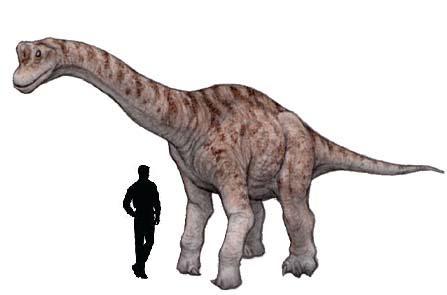
Sephiroth: he's uhh.... Weird. I would give him a Spinosaurus. Not only because of the vibes, but also because paleontologist have no fucking clue about most things about them. There's a big discussion happening in the paleontologist fandom™(/j) about whether the spinosaurus lived in water or earth. At first it was earth, yet a random Canadian decided they actually lived on water thanks to their similarities to cocodriles and reptiles similar to them, besides also having a long tail that could've been a fin. In my opinion, I believe on what some people say about spinosaurus actually living on both. There's also something cool that the big spine on their back was supposed to change colors depending on the Spinosaurus' body temperature, and they needed to get into the water to cool down.
Also, they eat fish. And fish = cats. And cats = Sephiroth
I feel like he would just... Stare at it. I don't know. And I'm pretty sure he doesn't know what to do with it either.

Angeal: I'm sorry I don't know much about him. I feel like he would have a Triceratops just because of the vibes. Another alternative is a Pachycephalosauria, they have a hard head and are very silly, I feel like he would find them amusing (as well as also similar to Zack).
No matter what option is, he would take proper care of them as if he was the one to give birth to the dinosaur.
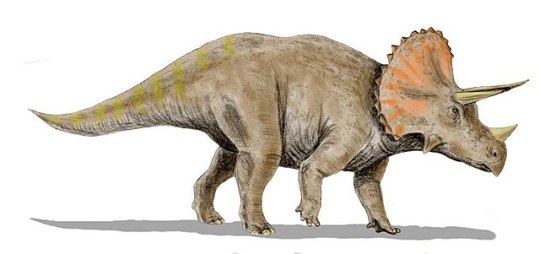

Zack: As a child I feel like Zack would've had T-Rex's as his favorite dinosaurs because he saw them in movies and toys and thought they were really cool. Yet, after watching the documentary/movie "Walking with dinosaurs" his favorite is the Pachyrhinosaurus. And I would give him that one.
He would probably do his best to take care of it without ending with his house completely destroyed and would buy matching hats/sweaters for them to wear. Also he would ride it as if it was a chocobo.

Cloud: at first I was thinking a Stegosaurus simply because of vibes, yet I'm going more with a Parasaurolophus. They're just chill chunky guys and I feel like Cloud wouldn't want to have any more problems added to his life.
Yet, they're too big... So another option I thought for Cloud are Velociraptors. And no, they look nothing like the ones in movies. They are AT BEST 0,5 meters tall(50cm), and they also have feathers. It would be like having a little Chocobo who wouldn't hesitate a second to eat you as soon as you're unconscious... But let's pretend this one is actually friendly and sees Cloud as family. Okay? Okay.

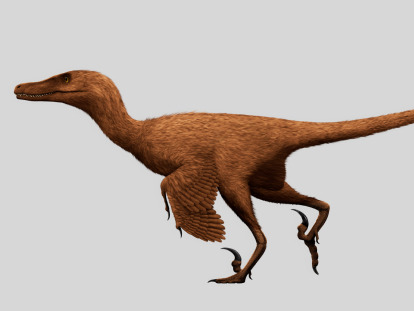
#ffvii#ff7#i love dinsoaurs sm i think i have a problem#final fantasy 7#final fantasy vii#sephiroth ff7#ever crisis#genesis rhapsodos#ff7 crisis core#ff7 ever crisis#ffvii crisis core#ffvii ever crisis#ff7 cloud#ffvii sephiroth#ff7 angeal#zack fair#ff7 sephiroth#dinosaur#ffvii angeal#ffvii genesis#cloud strife#ffvii cloud#first class#sephiroth#ff7 genesis#zack ff7#angeal hewley#zack ffvii#final fantasy 7 crisis core#final fantasy 7 remake
10 notes
·
View notes
Text
Time for a quick big-brain thought
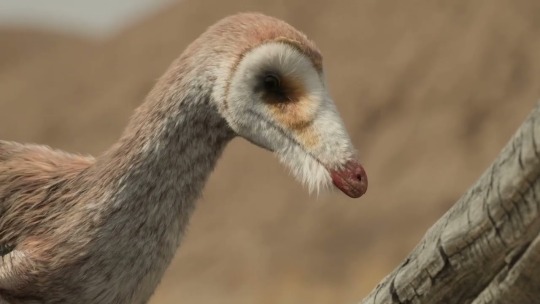

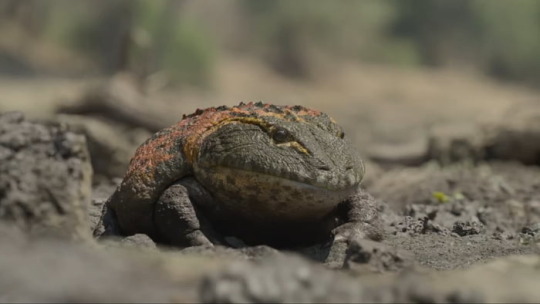

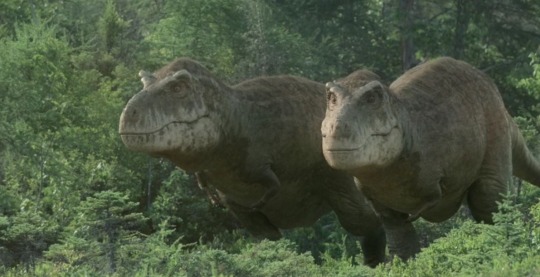
I know that I’ve made an entire hypothetical scenario for how a third PHP season would go last year, along with how the series itself hasn’t mentioned in any major announcements as of late, but what if this hypothetical third season had a major theme with its episodes?
As in, instead of using habitats as the themes, why not go with entire locales instead? Maybe this could be the show going back to some of its most famous settings before closing things out, but I feel like having future episodes focus on an entire location instead of a single biome in general could be an interesting way to deal with running out of compatible habitats. Hell, it could be a good way to not only introduce new species, but also bring back certain animals from past episodes. I know this is a little bit far fetched, but hear me out.
Nemegt (Basically the Nemegt Formation and the surrounding area)
Old Species- Tarbosaurus, Mononykus, Deinocheirus, Tarchia, Prenocephale, Barsboldia
New Species- Gallimimus, Udanoceratops, Saurolophus, Conchoraptor, Adasaurus, Brodavis
Patagonia (The southern part of South America, with places like the Allen, La Colonia, and Cerro Fortaleza Formations being found there. Areas like Chile could also fit)
Old Species- Carnotaurus, Dreadnoughtus, Austroraptor, Secernosaurus, Mortuneria (if we wanna continue with the idea of them being South American residents)
New Species- Maip, Stegouros, Aerotitan, Gondwanatherium, Sektensaurus, Noasaurus
Madagascar (Basically what it says on the tin)
Old Species- Majungasaurus, Rapetosaurus, Beelzebufo, Simosuchus, Adalatherium, Masiakasaurus, Madtsoia
New Species- Facatakely, Mahajangasuchus, Sahonachelys, Rahonavis, Vintana
Tethys (The European archipelago and surrounding sea, with places like Hateg Island, France, and even a small bit of Morocco being examples)
Old Species- Hatzegopteryx, Zalmoxes, Mosasaurus, Telmatosaurus, Barbaridactylus, Diplomoceras
New Species- Squalicorax, Ampelosaurus, Ocepechelon, Gavialimimus, Gargantuavis, Rhabdodon
Laramidia (Yes, I am aware that this could be like “North America” again, but with place like Hell Creek, Prince Creek, Ojo Alamo, and even parts of the inland sea that was still present at the time, there’s plenty of material to work with, even moreso than NA)
Old Species- T. Rex, Triceratops, Quetzalcoatlus, Alamosaurus, Edmontosaurus, Pachycephalosaurus, Pectinidon, Pachyrhinosaurus, Nanuqsaurus, Prognathodon, Hesperornis, Xiphactinus
New Species- Ankylosaurus, Anzu, Habrosaurus, Lonchidion, Thescelosaurus, Borealosuchus, Basilemys, Didelphodon, Bravoceratops, Bonnerichthys, Hydrotherosaurus
Is this a rather odd and ridiculous idea for a third PHP season that might not happen? Yes, yes it is. But, like with my of my other ideas and projects on here, it’s one that I wanna share to get input on.
19 notes
·
View notes
Photo

ugghh!!! pachyrhinosaurus's are my favorite but i rarley ever see any art of them >:|| so i made some!!!! *dies* anyways cant wait to go back to the little house in the forest bc i saw like 2 bobcats and they were so silly... . . #oc #originalart #originalcharacter #myoc #ocart #originalcharacterart #dinosaur #art #myart #artist #artwork #artistoninsta #artistoninstagram #artistsofinstagram #furry #fursona #furryartist #dinosaurart #aesthetic #paleoart #dinosaurs #paleontology #colorfull #digitalart #digitalillustration #digital #digitalartist #cute #artcommunity #thistagisforartists https://www.instagram.com/p/ClvMjIAuN9e/?igshid=NGJjMDIxMWI=
#oc#originalart#originalcharacter#myoc#ocart#originalcharacterart#dinosaur#art#myart#artist#artwork#artistoninsta#artistoninstagram#artistsofinstagram#furry#fursona#furryartist#dinosaurart#aesthetic#paleoart#dinosaurs#paleontology#colorfull#digitalart#digitalillustration#digital#digitalartist#cute#artcommunity#thistagisforartists
11 notes
·
View notes
Text

10 THINGS THIS FRANCHISE NEEDS
1- Bringing back old ambience less action based , more scince fiction and horror.
2- A new director who gets this series and real meaning of the original movie and books. Not someone who tries to make it like MonsterVerse or MCU
3- Live action series. I think instead of directly getting a new trilogy , we need a solid live action series. There is a lot of stuff they can do.
4- Since last movie finished the whole frog dna thing , we need to have more natural & organic looking designs. I am saying try to be %100 accurate. But put some effort to it. Look at the last dlc of JWE 2 and how much positive reactions it has. In these days , people want dinosaurs to be more realistic.
5- Stop making dinosaurs characters.
6- Having stronger human characters with deeper personalities. One of the big reasons why first 2 movies were great is , because it also had solid human characters. Malcolm , Grant , Hammond , Ellie , Muldoon , Sara & Timbo. All were great.
7- Work with Stan Winston studios again.
8- Go back in time and have some prequel stuff like a movie or a series. There are a lot of stories they can tell. Ingen clean up crew going to nublar short after 1993 incident. BioSyn invading Sorna or some people in Ingen worker village getting stuck in the island. After hurricane shutting down everything.
9- Please add more canon species. There are many canon animals who didn't showed up. We want them. They should have priorities compared to new species. Edmontosaurus , Pachyrhinosaurus , Lesothosaurus , Herrerasaurus , Metriacanthrosaurs , Coelurus and Suchomimus. Those are some examples
10- We need a solid JP/JW survival game.
2 notes
·
View notes
Text
Prehistoric Combat

One of the oldest stereotypes when it comes to dinosaurs is the notion that they are essentially violent monsters. That they're always looking to pick a fight and have a habit of getting into bloody death matches. Now to be fair, this is understandable with earlier depictions since very little was known about them, and the sheer wow factor inherent with seeing two or more gigantic animals fighting each other. There's nothing inherently wrong with it alone.
The problem comes when people assume that's all they do. That's when people forget that dinosaurs were...well, animals at the end of the day. And bloody death matches shouldn't be what defines them as a whole.
And this scene from Prehistoric Planet shows that a hunt doesn't need to be bloody to showcase how powerful these animals are.
Basically, a pack of Nanuqsauruses hunt down and eventually encircle a herd of Pachyrhinosaurus up in the far north. Rather than go on the attack though, the Nanuqsauruses hang back, well out of the ceratopsians' range. They know that a frontal assault is suicide since the Pachyrhinosaurs are clearly bigger and a lot stronger together. One is even shown knocking down one Nanuqsaur when it gets too close. And their strength is shown when the leader of the herd makes a mock charge, and the hunters give him a wide berth.
On the other hand, the same goes the other way. That Pachy that knocked over the Nanuqsaurus? It immediately turns and retreats to the safety of the herd. And the Nanuqs aren't idle either. They make probing attacks and mock charges of their own to psyche out the herd and try to cause panic, and they do manage to rattle the herd several times. Both sides are shown to be evenly matched, and the behavior shown by hunter and prey reflects that.
It's less about violence and more about the two sides trying to break the other. And it gets pretty grueling since the standoff lasts days. Not helping matters is that a blizzard comes roaring in, forcing the dinosaurs into a stand off as they hunker down and weather the storm. A battle of endurance essentially.
Eventually though, the blizzard breaks and the battle continues. However, days of a tense stand off and plummeting temperatures have wrecked havoc on the dinosaurs' nerves, where eventually a Pachy snaps and makes a break for it, causing a stampede. As a result, an older and weakened bull is left behind to face off the Nanuqs by himself. Tough as he is, he's surrounded, outnumbered, and weakened by the standoff, allowing the predators to take him down.
Personally, this is one of my favorite examples of dinosaur on dinosaur action cause it finds a happy medium. All the dinosaurs look powerful without becoming mindless brutes and they still deliver a pretty intense sequence. I hope in the coming years we get more depictions like this where dinosaurs are depicted as less monsters and more the animals they really were.
229 notes
·
View notes
Text
Avaceratops lammersi
('Ava horned face, for Arthur J. Lammers family')
Centrosaurinae Nasutoceratopsini
Named for discoverer Eddie Cole's wife, Ava, and the family that owned the ranch where he found it.
In 1986 Avaceratops became the first new ceratopsid described since Pachyrhinosaurus in 1950, a couple of generations earlier. (How long is a generation?) You kids today are spoiled for new horned dinosaurs. Back in my day, we had five or six ceratopsids to share between all of us, and we liked it! 😆
There is some disagreement on the size of Avaceratops, but I'm going to put her right around 1 tonne and 4 m long.
Judith River Formation, Montana, USA.
Upper Cretaceous, ~77 Ma.
~
Artwork by Andrey Atuchin.

Daily Dino Facts #2
16 notes
·
View notes
Text
How to Write (Accurate) Dinosaurs (Follower Article Submission)
By Salvatore Cucinotta
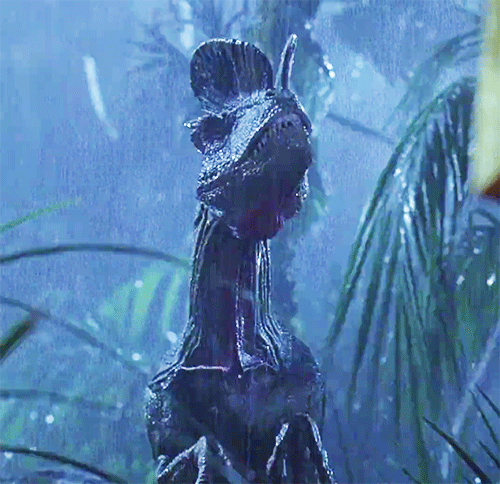
Dinosaurs are probably the most popular subject in natural sciences and show up in fiction in so many roles it’s dizzying. But they are rarely shown with any accuracy. Depending on the story, that’s okay, and nothing to be ashamed of. However, the opportunities presented with more accurate dinosaurs can often outstrip the flights of fancy they have often been assigned. There’s a lot to cover, because dinosaurs are a very diverse group of animals, and we’ve learned a lot about them since they were first discovered: Even more things recently that get ignored for the ‘popular conscious’ image of these animals.
If you would like the opportunity to write an article on something you’re passionate about for The Writers’ Helpers, please click here.
Taxonomy: Understanding through Relatives
The first thing to understand is about dinosaurs is where they fit in the tree of life. Their taxonomic cousins are Crocodilians, and their direct descendants are birds. This does mean that birds are dinosaurs. Between the two, we have some very interesting and diverse templates to draw from for comparison. We can also make some speculations on things they may have done when the fossil record doesn’t fails us. This article is going to go on with a mixture of things we do know, and things we can infer. If anything strikes you as off or odd, I fully encourage you to dig deeper on your own. Heck, by the time this article comes out, a new find or paper could make some major changes to the broad generalities presented here. But, for now, if you want to get a simplified understanding, Dinosaurs mix some of the best features of crocs and birds, which allowed them to dominate the world for millions of years.
Jaws and Teeth
With that settled, let’s focus on the animal piece by piece, starting with the head. Dinosaurs tend to have rather powerful jaws. Tyrannosaurs are famous for it, but the bites of most dinosaurs are nothing to sneeze at. Their modern relatives, Crocs and birds, are rather noted for how powerful their bites can be. This is because they all share a similar muscle structure. They have two pairs of muscles on the back of their head as well as one in the center of their head (between the eye and nose) which are all to make the bite that much more powerful. In many dinosaurs, these show up as holes so they can be clearly seen. By comparisons, mammals only have one pair of extra muscles in the back for jaw reinforcement. This is why crocs can crush bones and parrots can crack Brazil nuts. So it becomes easy to picture: a Hadrosaur pulling off chunks of tree wood in tough times, a ceratopsian munching down an entire bush to its stem, or a tyrannosaur, which have the most powerful jaws among dinosaurs, crunching up the bones of its prey. Their jaws are not to be taken lightly. Other big predators have weaker jaws than Tyrannosaurs, but still enough to leave scratch marks on bones.
Teeth come next, and dinosaur teeth are as diverse as their diet. The sauropods have simple, peg like teeth for stripping plants. Others, like Ankylosaurs and Stegosasurs have beaks to crop plants, largely forgoing teeth. All these animals likely had gizzards or advanced stomachs or breaking down plant material like modern birds do (we have known examples from Sauropods, but not from the others, but it would make sense). Ceratopsians and Hadrosaurs have massive batteries of teeth for chewing, and powerful ones at that. Ceratopsians shifted their jaws back and forth to chew rather than side to side like mammals do, while Hadrosaurs did something really weird: they flexed their skull. While their lower jaw just moves up and down, the top looks like it’s squeezed by an invisible hand as they separate, which flexes out when the close, grinding any food caught between them as the top teeth slide down and out over the lower set. In life, it would give it very puffy cheeks as it chewed. Finally, predators largely have teeth for slicing flesh and creating gaping wounds in their prey. Except Tyrannosaurs, those animals had more conical teeth for crushing bone and armor, especially Tyrannosaurus rex. After getting a small enough food item in their mouth, they’d then swallow it whole. It seems theropods ripped prey apart like modern birds do, holding it down with a foot and plucking chunks off to be swallowed.
Tongue Actions
Staying in the mouth, let’s talk about tongues. Our two modern examples show great extremes. In Crocodilians, their tongues are fused to their jaws, while in birds, they can take a variety of forms. This is generally covered by the hyoid bone and a study from June of 2018 ran through what we have of hyoid bones. The short of it being, most carnivorous dinosaurs and the big long-necked ones had crocodilian tongues (yes, even the birdlike ones), while the Ornithischian dinosaurs (duck-billed dinosaurs, horned and armored dinosaurs, etc.) had tongues and could be a bit more elaborate with them. Given the simple jaws of Ankylosaurs, it is thought that their tongues might have been used to aid in grazing, being large, rough, and possibly used in pulling in food.
Horns, Frills, Domes, and Other Weirdness
Now there are dinosaurs that have horns, domes, crests, and other ornamentation on their heads, but they didn’t all use them for the same purposes. In Theropod dinosaurs like Ceratosaurus, Allosaurus, Cryolophosaurus, Carnotaurus, and even Tyrannosaurus rex, the horns, frills, and bumps were most likely display pieces like that of a modern hornbill. They look pretty, but don’t do much else. The Pachycephalosaurs dome heads are often shown ramming each other, and that’s likely accurate. We do have some evidence of lesions from impacts they could not withstand on their massive heads. Now, the Ceratopsian dinosaurs use their horns depending on their family. Chasmosaurine ceratopsians, such as Triceratops, Charmosaurus, and Torosaurus, likely locked horns like deer in shoving matches when battling each other, and used the sturdier horns to defend themselves when they could. Centrosaurine ceratopsians, including Monoclonius, Styracosaurus, and Pachyrhinosaurus did more body shoving and scraping with horns along the frill. So, instead of butting heads, they’d either T-bone their rival, or they’d circle each other to try and flip or knock over their foe. Finally, there’s the big tubes along the heads of lambeosaurine hadrosaurs. These were echo chambers for sound, which will be discussed in more detail below, but in general, these made deep, resonating sounds.
The frills of Ceratopsians likely served two purposes: defense and display. Display among other members of their species being the primary with defense a secondary bonus. And it wasn’t just bone covered in skin. The frills were covered in a keratin sheath like their horns and beaks, and like the beaks of modern birds. This means that they were quite durable, and possibly even brightly colored in life. It’s also fun to note that Tyrannosaurs had a habit of ripping off those frills in order to eat the thick neck muscles behind them.
Of course, the thing about Dinosaur heads, especially in Tyrannosaurs, Hadrosaurs, Ceratopsians, and likely Pachycephalosaurs is how much they change as they the animal ages. Ceratopsians show the most change, as they are born with frills and horns that can barely be notices, but which grow into different shapes for each stage of life. Triceratops has 5 distinct growth stages that we can determine so far, and it is likely other horned dinosaurs had similar stages. Hadrosaurs start with ‘cute’ faces, short nose and big eyes, and which elongate as they age. Tyrannosaur skulls deepen and become more robust as they age, to the point where young Tyrannosaurs have more teeth than the adults. Pachycephalosaurs might go through the most changes, starting with horn-covered heads before growing the dome as the horns shrink, but because their remains are rare and usually incomplete, we can’t say this with certainty.
As a final to-do regarding horned dinosaurs, it has been noted for years that their skulls have massive openings for their nasal passages. Holes far too big to just be for an enhanced sense of smell. One hypothesis about them is that they held air sacs that could inflate for display purposes, like that of a modern hooded seal. If that hypothesis held true, then they would be very showy animals.
(Almost) Bird Brains
Our last stop in the head is in the brain. Dinosaur intelligence is hard area to study since brains themselves don’t fossilize, but the braincase gives us some idea of its size and shape, and thus what it could focus on. This is made trickier because of the transition from more reptilian forms to avian ones, but, again, it gives us a rough estimate of what’s going on between their ears. From what we can deduce, animals like Allosaurus and Carcharodontosaurus were about as smart as modern crocodiles, with smarter ones on the way to being bird like. Some, like Tyrannosaurus, are only just, while one of the most intelligent dinosaurs (Troodon) is about 31.5 to 63% of the way to modern bird intelligence.
This does downplay the movie “Raptors” unlocking doors, or being as smart as crows or parrots, but it doesn’t make them unthinking, unfeeling beasts either. Again, crocodiles are more nuanced than most people are aware. Crocodiles have been seen bringing food to their babies, using very simple tools (putting moss and sticks on them to aid their camouflage), and can be taught a few tricks. They also play. They play with objects (wooden balls, noisy ceramic bits, their prey, floating debris, and even streams of water), they engage in movement play (surfing in waves, using waterslides, and riding currents), and even playing with others. And not just other crocodilians, but otters and even some people. Some of these play bonds can last for years. Crocodilians aren’t just reactive to their environment, they have flexibility in their behavior.
And no dinosaur has a secondary brain in the back to help out. That is total bunk.
All the Better to See You With
We can also tell a lot about the animals’ senses from these brain casts. In general, however, we can say that dinosaurs have great senses of smell and eyesight. Their hearing was good, but geared towards hearing lower sounds than humans are used to. This means that overall, the “It can’t see you if you don’t move” trick from Jurassic Park is patently false. Not only could it see you clearly, and in color, but it would just as easily identify a target through scent alone.

Resonance
Moving down to the throat, we enter the realm of figuring out what sounds dinosaurs made. This is a big area of curiosity, especially with the crests of the various Hadrosaurs being full of air tubes like massive instruments. The sounds of those is pretty well known – something like an alpine horn, but that’s not the limit of what sounds they could make. Modern birds would easily be a writer’s first thought. Birds make all sorts of sounds, from hooting owls to the lyrebirds’ perfect mimicry. However, Dinosaurs don’t have the bones for it. Most of those sounds are made with a bone known as the syrinx. This bone evolved in birds after they became their own group, and is found in no non-avian dinosaurs.
But that doesn’t mean they can’t make noises. Ostriches and bitterns and make booming sounds without the use of their syrinx, and crocodiles are very vocal animals. The chirp of crocodile babies in the nest is well known and documented, as is the mating bellow, and threatening hiss. But there are also calls to alert others to danger, call for help, and even an ‘Umph’ call to assure babies that their mother is near. These tend to be low, deep sounds for the most part, with the mating call going into infrasound ranges. This matches with many types of Dinosaurs. The singing Hadrosaurs and Tyrannosaurs both geared their ears for low frequency sounds. The Hadrosaurs to hear and locate each other, and Tyrannosaurs to listen in and find prey. This means that Tyrannosaurus wouldn’t roar, but something scarier. It could produce this sound without opening its mouth, and even if a hapless human couldn’t hear it, it would reverberate through their entire body.
Dinosaurs Can’t Play Basketball
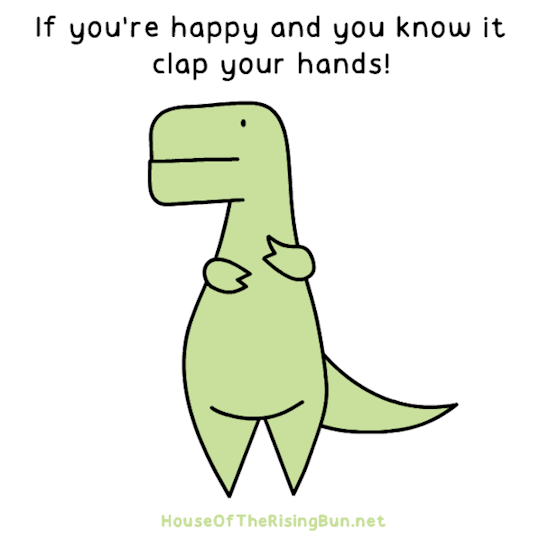
The next thing to talk about is in the hands. In movies, and even in mounted skeletons, dinosaurs are often shown with their palms facing the ground. It gives raptors a praying mantis-like arm pose and is a product of anthropomorphism. Dinosaurs did not hold their hands like we do. Birds are dinosaurs, and birds hold their hands with their palms facing inward. Maniraptors (a group of dinosaurs including Oviraptor, Velociraptor, and modern birds) could almost fold their arms up like a bird does, though their fingers point to the ground getting only half way to a full bird fold-up. This is important for them because it allows for a ‘flapping’ motion. With this down, they could do all sorts of displays, catching small prey, or execute tighter turns.
Gut-Punch
The next topic is inside a dinosaur, and that is gastralia. This, in birds, is known as the sternum or breastbone. In dinosaurs, it’s basically a set of 8 to 21 reverse ribs that run along the line of the stomach. It is known to be present in Crocodiles and the Tuatara, and we have fossil evidence for it in many Theropods and Prosauropods. It seems to be absent from the giant Sauropods and Ornithischian dinosaurs. In life, they provide extra protection and muscle attachment points for the body mostly related to how they breathe.
Huff and Puff
Dinosaurs, like their descendants and relatives, have extremely efficient and powerful lungs unlike any other group of animals. They cycle through without pause, cleanly and efficiently. Throw in the hollow bones of Sauropods and Theropods, and like birds they become even more efficient with their breathing. This means they have very high endurance. The marathon flights of birds are a good benchmark for non-bird dinosaurs. It also means they can survive lower oxygen levels than us mammals can with fewer side effects. So the longer a chase scene goes on with a dinosaur, the more likely it’s going to win.
Serpentine! Serpentine!
The legs come next, and they are one of the defining features of dinosaurs and birds. They are extremely efficient runners. Their ankles and knees are simple door hinge joints, and their hips connect to their legs with a wheel joint. Even better, dinosaurs have a muscle attaching to the back of their thigh and connecting to their tail, making their run that much more powerful and efficient. So, dinosaurs can run quite well and for long periods of time. But they have trouble on turns. The tail can be used as a lever to aid in turns, but they’d still rather run straight than turn. So, when chased by a dinosaur, the best strategy is to get to cover and zig-zag randomly. Because you sure as hell aren’t outlasting them.
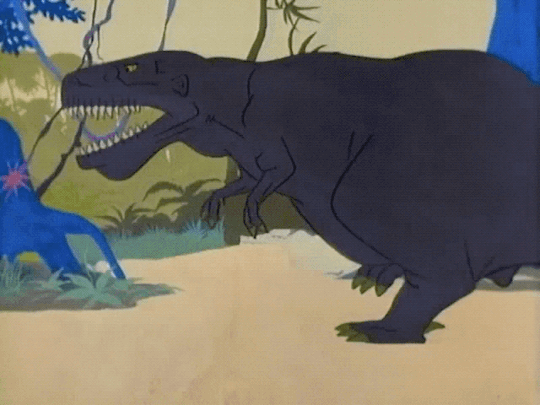
Speed wise, dinosaurs can do pretty well. It varies a lot by species. Tracks can tell us some answers, as can biomechanical analysis. It’s hard to pin down, and many a mathematical formula has been put together to try and figure out these speeds, with some variable ranges. The big theropods have a speed range between 10 and 25 mph. Large raptors around 20mph, with their smaller relatives 25-30mph. Smaller therapods can hit up to 45 mph, with the Ornithomimids hitting 50 mph at the most. The hadrosaurs tend towards 25-30mph. Ceratopsians tended to run at most just under 20mph. Armored dinosaurs and large sauropods tend to be the slowest, the fastest of these going roughly 6 mph.
Like today, predators have quicker pickup than herbivores, who are geared for more long distance running. Throw in all those adaptations for endurance and we have some real marathon runners here. In other words, predators tend to be sprinters, herbivores tend to be distance runners, but both are distance runners compared to mammals.
Ouch!
While we’re inside, let’s talk briefly about healing and injury. Dinosaurs are quite robust and tough animals. Their immune system is that of birds and crocodiles. When faced with an infection, their immune system isolates it. This makes it take longer to heal, but prevents septicemia/blood poisoning among other benefits. This does sometimes lead to amputation of toes in some animals. There are instances of healed creatures in many skeletons, though a bad break in a leg or along the spine can still be fatal. They still suffered some diseases. Tyrannosaurus for example has evidence from several individuals of a bone infection that seems to have been spread among them via face biting. Whether this face biting was social interaction of some sorts, violent interspecies conflict, or minor dominance displays while feeding like wolves do today is unknown.
Warm Blooded, Cold Blooded, or Something In Between?
At this point, it’s pertinent to mention how active dinosaurs were. The term “Mesotherm” is often put about them, and it seems to fit. They are between “Hot Blooded” Endotherms like birds and mammals, and “Cold Blooded” Ectotherms, like crocodiles and other reptiles. The short of it is, Dinosaurs were on a gradient of activity levels. Mostly above that of modern crocodiles (who are already geared to be as energy efficient as possible), up to that of modern birds. They wouldn’t bask in the sun by and large, but could do with less food than a mammal of similar size. What’s really fun is the cheat they use to assist that even more. See, most energy in mammals and birds is used to keep us warm and active. But this has a direct relationship with body size. The smaller an animal is, the more energy is needed to keep it warm. But large animals can keep themselves warm through their bulk alone. This is sometimes termed “Gigantothermy.” And dinosaurs hit that sweet spot really well, being able to outdo mammals and be more fuel efficient while doing so. Still, if the idea of the warmth of a group of mammals seems fanciful, remember: opossums, echidnas, and platypus’ have an average body temperature so low none of them can carry rabies.
The Way Out
Next, we come to an ‘exit’ from the internal stuff: a dinosaur’s butt, because dinosaur butts are weird. See, mammals from horses to humans are … different from other vertebrates. We have separate orifices for releasing both forms of waste as well as our reproductive system. Most other animals, well, they have their waste disposal plant and their amusement park in the same place. This is called a cloaca and is a universal organ for waste and reproduction. Birds, crocs, and dinosaurs have it. Even egg-laying mammals have it. It’s the standard from which modern mammals deviated. Because of this, dinosaurs can’t use urine to mark territory because they have no way of expelling it separate from other excrement. So, dinosaur poo would either be like that of a bird, or like that of a crocodile. On the plus side, this does make them quite good at retaining water, and makes them basically immune to being kicked in the crotch.
Eggs, Nests, and Parenting.
The other thing to come out of that hole, eggs, leads easily into nesting behavior. We only have a few nests we can fully identify, as well as dozens more which we can’t tell who they’re from. And the nests and their uses varied a lot. Some animals were nest bound after hatching, dependent on the parents for food. Others were like young reptiles of today, hatching ready to move and work largely on their own. It is likely, given crocodiles, that there was some parental protection early in life for most species. They had a high number of young, which compensated for the high attrition rates of young individuals. So, even the best mother lizards would lose quite a few children with each brood. In short, seeing a single child from a nest or as a yearling is not only inaccurate, but has extremely depressing implications.

In general, there were two major methods of nest building: the crocodile method, and the bird method. The crocodile method was taken up by the majority of dinosaurs. This being building a nest of rotting vegetation and covering the eggs, letting the warmth of rotting vegetation incubate the eggs. The latter is far better known, where the parents) use their warmth to incubate the eggs (though they were nested in rotting vegetation as well, a between stage for bird and crocodilian styles as it were). This more modern strategy is only found in smaller animals, and of those, the ones that were heavily feathered.
Scales, Dino-Fuzz, and Feathers
Yes, feathers. Dinosaurs have feathers. This is partly because birds are dinosaurs, and partly because of the “Ancestrally Filamentous Hypothesis” where the common ancestor of dinosaurs were likely feathered, or more accurately covered in filaments that are ancestral to feathers. This is because we have dinosaurs on both major branches with feathers and filaments of varying types and it is likely that they are from the same source, but it could be independent evolution as well.
But what’s really weird about dinosaur feathers is the fact that they are not mutually exclusive (meaning a dinosaur can have feathers and scales, and not just in patches either, but all mixed together), that some of the scales on some dinosaurs might be feathers that have become scales once again, and that there are occasionally multiple stages of feathers present on the same animal. There’s three basic stages (with 5 when you really get down to the nitty gritty things). These are the filament (hollow hair-like feathers somewhat similar looking, though often shorter, than what is seen today in emus and kiwis), plumulaceous (Fluffy down-like feathers), and pennaceous (and branching feathers from a central shaft). The latter are the majority of feather types on a bird, varying in how they are interwoven.
Armored dinosaurs (Stegosaurs, Ankylosaurs), Pachycephalosaurs, and Sauropods have no direct evidence for feathers on them, and aside from polar animals, very small animals, or sporadic display points probably didn’t have any. The scale impressions we have of sauropods and Ankylosaurs indicate rather crocodilian-like heavy scales, with smaller ones at the joints to ease movement. This includes the armor which, like the backs of crocodiles, were scales with boney core. And yes, some later Sauropods (such as Saltosaurus and Alamosaurus) did have body armor, though not to the extent of Ankylosaurs.
Ceratopsians or Horned dinosaurs have evidence of the first type of feathers on their bodies, namely long quills on the top of the tail of Psittacosaurus (along with a skin of fine scales whose coloration, that is similar to a modern deer, was also preserved). The skin impressions of Triceratops dinosaurs show they had more crocodilian-like armored scales, but also knob points where either spines or feather quills could have grown out. Given the size and placement, they might have been for display structures or they could have been more porcupine-like quill spines. But because this specimen is in the hands of a private collector, it has so far not been studied.
Ornithopods (duck-billed dinosaurs, Iguanodons, and small herbivores often called “Hypsilophodontids”) have several mummies preserving scaly skin, but Kulindadromeus, a primitive member of this family, had a very distinct body covering. Its face, shins, and tail were scaly, easily enough. But the torso, neck and head were covered in filamentous feathers, while its arms and thighs had plumulaceous coverings. So, it’s possible for Ornithopods to have all sorts of feathers, though it seems the larger ones preferred scales as far as we can tell so far, it doesn’t rule out feathered parts of the body as well, or mixed/alternating scales and feathers like the feet of some birds have.
Therapod feathers are extremely complicated since they include birds, and show the most diversity. We generally don’t have evidence for feathers in Ceratosaurs, Abeliosaurs, Megalosaurs, Spinosaurs, Allosaurs, or Carcharodontosaurs, but because of what we know of their ancestry, it is possible these animals had at least some filaments in scattered parts for display. Compsognathids and Tyrannosaurs have family members depicting plumulaceous feathers, including Yutyrannus which is so far the largest dinosaur to have such feathers (30ft long).
From there we get into properly bird-like and the feathers become more obvious. Therizinosaurs have plumulaceous feathers, while Oviraptors, Ornithomimids, and “Raptors” all have pennaceous feathers. Meaning that the latter three had wings. They couldn’t fly with them (well, maybe the juveniles can when they’re small and light enough for it), but they are still useful for a wide variety of things: shading young/eggs when nesting, social displays/mating dances, guiding movement when running like modern ostriches do, to aid in climbing like modern birds use them for (flapping furiously), or to pick up speed while running, or use them for balance when sinking their claws into prey like modern birds of prey do. There are a lot of ways birds use their wings for reasons other than flight, and the same might be true for non-avian dinosaurs that had them.
But let’s not forget the scales too. The do appear on dinosaurs are for the most part rather small. The scales preserved on tyrannosaurs are best measured in millimeters, with an animal up to 40 ft. long, it would make the skin look rather leathery at a distance, but when you get close to it and feel it, it would be rougher, pebbly, but still rather soft like a bird’s foot. Some animals, like Edmontosaurus had a mosaic of tiny scales where the animal would flex, with sections of larger, bumpier scales in between. And then there are the more armored ones on Sauropods and Ceratopsians. Overall, each dinosaur is going to look different from what you see in Jurassic Park.
But, in short, a dinosaur with feathers is more accurate than one without them.
Other weird skin-related tissues include: Edmontosaurus annectens of the animal having a crest of soft tissue or wattle like that of a chicken, Tarbosaurus bataar having a throat pouch like a modern frigate bird, and Diplodocus having Iguana-like spines down their back (though how big they are in proportion to the rest of the body is unknown).
Modern birds have a myriad of fleshy formations on their heads, as well as bizarre ways of arranging feathers. From turkeys and chickens, to kiwi whiskers and quails topknots, don’t be afraid to use them to lend character to your creatures.
Colors
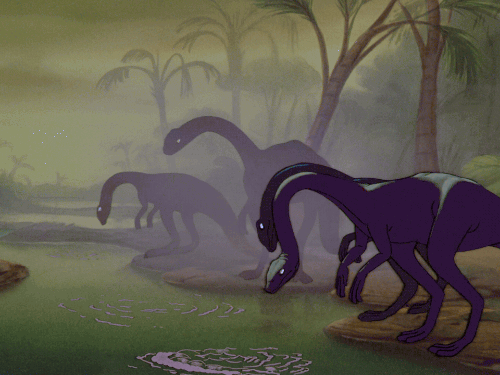
The last part to talk about is color. We actually do know the coloration of a few dinosaurs. Psittacosaurus and a medium sized ankylosaur Borealopelta have deer-like countershading coloration. A tan brown up top with a lighter color for their belly and dark patches around the face or armored scutes. Yes, even armored Ankylosaurs have camouflage. And those were scaly animals for the most part, most color information comes from feathers. Anchiornis feathers are largely black with blotches of gray, splashes of white (forming a white background with black spots across on the wings), and a brilliant red crest. Sinosauropteryx has a color pattern very similar to that of a modern coati, orange-brown up top with a lighter belly, bandit-mask of orange-brown over its face and white/orange-brown stripes running up its tail like a ring-tailed lemur. Finally, the proto-bird dinosaurs Archaeopteryx and Microraptor were black for the most part, with Archaeopteryx having white tips, and Microraptor’s black being more iridescent-black.
This means that, color wise, we have a lot of options between these findings and what we see in modern birds. Animals that rely on camouflage would do their best to match their environment: browns, greens, and blacks being common. But we’d also see brilliant colors for display, possibly leading to dances that go with the colors. Predatory dinosaurs might have colorations similar to eagles and hawks of today. Think first of where the animal lives and what it’s doing. Then you’re going to have to think of birds or other animals that fill a similar basic role and see what catches your eye.
I Blame Society
There’s only so much we can say about behavior that is not tied to the body directly. Footprints tell us some things, but only give us short scenes. Still, we can say a few things with some confidence. There are three ways Dinosaurs group together. The first is in what is best termed a flock. They travel among their own kind as a group for protection. We see this in sauropod trackways, mass grave sites of ceratopsians, and among hadrosaur group nesting sites. It seems Ankylosaurs were mostly solitary. Other dinosaurs seemed to form smaller groups if at all. The next structure is rare and rather speculative: a pack. Popularised among “raptors”, there is also evidence for this among some Tyrannosaurs. A pack is a family unit with parents and children being raised together, sometimes in expanded form. It’s common in mammals, but rare in modern dinosaurs. Only the Harris Hawk displays this social structure, though crows have something...similar, but different crows are always outsmarting things. The last is possibly the most frightening: a bask. Crocodiles can be social animals. In fact, many are. They gather together in certain locations they know food to be plentiful and wait together for it to show up. This is probably best exemplified by the river crossings of wildebeest and zebra in Africa. Crocodiles gather at these points to wait for their prey to arrive, and then work together to take down prey as well as rip it apart. There is evidence of such basks being used by Allosaurus and it is not much of a stretch to extend it to related animals. They gathered by a watering hole in the dry season and took down prey that came to drink.
Wrap-up and Further Reading
This is a lot to digest, but it should give you a very solid handle on how to handle dinosaurs going forward in your stories. They are weird and wonderful animals, but never forget that they are animals and not monsters. It’s fun to hype of the deadliness of predators, but remember: the most dangerous animal in Africa is an herbivore, as are most of the “African Big 5”. Herbivores are more likely to (and more willing to) kill than predators. They just want an easy meal.
If you want more information, and can’t make it to a museum to talk up a volunteer or a resident paleontologist, I suggest checking out the tumblr A Dinosaur a Day, the youtube series Your Dinosaurs are Wrong from the Geek Group, as well as the youtube channel Trey the Explainer.
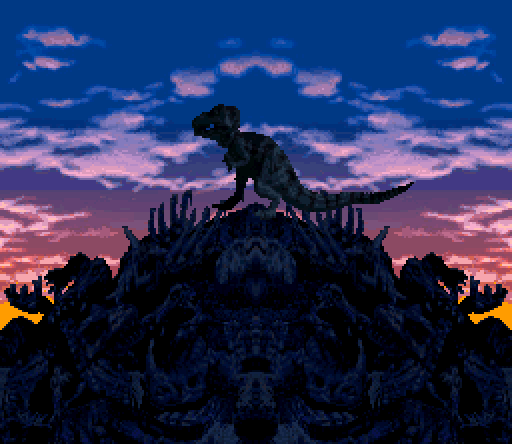
#How to Write Accurate Dinosaurs#Writing Help#Writing Dinosaurs#Dinosaurs#Writing Advice#Comprehensive Writing Guides#TWH Follower Article Submission#majingojira#Describing dinosaurs
169 notes
·
View notes
Text
An Analysis of the Creature Designs in Jurassic Fight Club
The 2008 History Channel miniseries Jurassic Fight Club was not a good show. Almost objectively, it was a badly-done series. The effects were of generally high quality, but those decent effects were in service of a poorly-scripted, gratuitously-violent, scientifically-inaccurate gorefest masquerading as a documentary.
It’s not worth your time.
That said, one bit of unambiguous praise I can give it lies in the designs for the dinosaurs. While they are frequently very inaccurate, they are completely unlike any dinosaur designs in any other media. The showrunners very easily could have just appropriated stock footage from older programs to pad their runtime, but they created unique clips featuring their own designs, which is commendable.
In this post, I’m going to be going through all of the creature designs that appear in Jurassic Fight Club and give my honest thoughts on them. I will factor in both accuracy to the real animal and my own personal tastes, and ultimately assign each one a score out of 10.
So, without further ado, let’s begin:

Majungasaurus crenatissimus (male)
Let’s cover these in order of appearance, which means that the male Majungasaurus is first on the plate. (I am choosing to ignore that they call it Majungatholus in the narration; that is not what this creature’s name is.)
This is a pretty interesting portrayal of this animal. They very easily could have just thrown some skin over the bones and called it a day. But, they stretched their creativity a bit and gave it some speculative soft tissue, and I like that.
That said, the anatomy is completely wrong for a Majungasaurus. The skull is correct, but the arms are too well-developed, and the legs are way too long and lean. Those proportions would work pretty well if this were a Carnotaurus, but it’s a bit too athletic for a majungasaur.
7/10.

Majungasaurus crenatissimus (female)
This is much more in line with what I was expecting from their Majungasaurus. It has the exact same problems as the male, and is missing the speculative soft tissue that I liked so much. Still okay, but not as interesting as the male.
6/10.

Tyrannosaurus rex
No, I don’t know why it’s squatting like that in this promotional image.
Ignoring the weird pose, this isn’t too bad, actually. Sure, it still has broken wrists, and the skull is a bit off, but it otherwise looks about right. For a depiction of T. rex from 2008, this is pretty decent stuff. I like the muted purple color, and I am immensely appreciative of the fact that they didn’t just copy-paste a Jurassic Park rex into their show. They could have very easily done that, but they chose to make something more representative of the actual animal.
8/10.

Nanotyrannus lancensis
This one’s a bit tough to judge. You see, Nanotyrannus doesn’t actually exist. In 2008, it was considered its own genus. But, in the decade since this series aired, it has been all but confirmed that Nanotyrannus is just a juvenile Tyrannosaurus.
That said, as a juvenile Tyrannosaurus, this is pretty good. It’s slim and fierce, with a good color scheme and decent accuracy to the fossils. Aside from the fact that this animal never existed, this is decent. Not bad at all.
7/10.

Deinonychus antirrhopus
I am of completely mixed opinions about this one. On the one hand, aside from the broken wrists, the anatomy is pretty much spot-on. You can tell that the designers actually looked at real Deinonychus skeletons to model this. Also, the blue body with the striping on the tail is a very striking color pallete. As a design, this is actually pretty good.
But, then we get to the elephant in the room. Not a single feather to be found anywhere on its body. Even in 2008, no feathers at all was barely acceptable, and it is completely unforgiveable today.
I have heard that they didn’t do feathers because of budgetary restrictions, which is understandable, but it does drag this design down quite a bit.
I’m going to have to give it a neutral score. It’s a great monster design, but it’s a terrible raptor.
5/10.
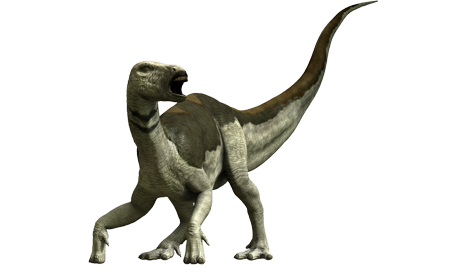
Tenontosaurus tilletti
Poor Tenontosaurus. It pretty much only ever gets media representation so that it can be killed by either Deinonychus or Acrocanthosaurus, and nobody ever seems to give it the time of day.
Fortunate, then, that this is a fantastic design.
Anatomically, it’s spot-on. The colors are dull, but not boring. It has a good amount of soft tissue, and carries a real sense of weight. Out of all the dinosaurs in the show, this one looks the most like a real animal. I have absolutely no complaints.
10/10.

Stegosaurus ungulatus
This is top-quality stuff right here. The proportions are good, even if the tail is a bit on the short side. The hands have the correct number of digits, and all of the plates and spikes seem to be in order. Again, the colors are a bit drab, but it feels appropriate for an animal of this size.
Also, how strange is it that, of all shows, Jurassic Fight Club is the only one I’ve seen that gets Stegosaurus’s weirdly long neck right?
Another triumph.
10/10.

Ceratosaurus nasicornis
Wow.
This is almost entirely perfect.
It has the right skull, it has the long teeth, it has the osteoderms on the back, the proportions are correct. Literally the only inaccuracy I can find is the pronated wrists, but that’s hardly enough to tarnish this thing’s otherwise perfect score.
This may be the best depiction of Ceratosaurus I’ve ever seen, and it is unquestionably the best design in the show.
10/10.

Camarasaurus supremus
Eh.
It looks about right, but it just feels...plain. This is the first one where the dull color scheme is a downside. It’s just flat grey with a yellow head. I do like that detail, but that’s pretty much all it has going for it.
Also, it has elephant feet, which is just wrong.
4/10.
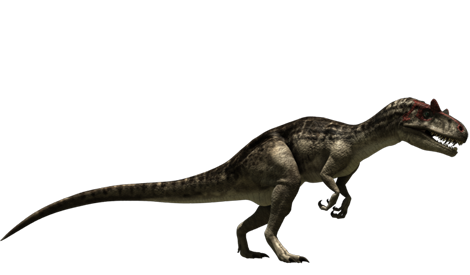
Allosaurus fragilis
Alright, buckle down, because this one’s really bad.
Whereas everything up to this point at least feels like they looked at the actual animal as they were rendering, I’m not certain anyone involved in this thing’s design process had ever seen an Allosaurus skeleton. Let me count the issues:
The skull is so utterly wrong I’m unconvinced they didn’t just completely make it up.
The horns are the wrong size, the wrong shape, and in the wrong spot.
The wrists are broken and stuck on the end of way-too-long human arms.
The torso is too shallow, and has this weird hunchback thing going on.
The legs are too short, and those dainty little feet are bordering on comical. It doesn’t look like it should be able to stand up.
Literally no component of this thing’s anatomy resembles the animal it is supposed to be. It’s a trainwreck.
1/10.

Carcharocles megalodon
To begin with, yes, I am all aboard Team Carcharocles.
With that out of the way, this is a very “meh” design. It’s literally just a big great white shark. No real creativity or imagination at play here. Normally, that would be fine, but C. megalodon isn’t particularly closely related to the great white, so I can’t rate this too highly.
4/10.
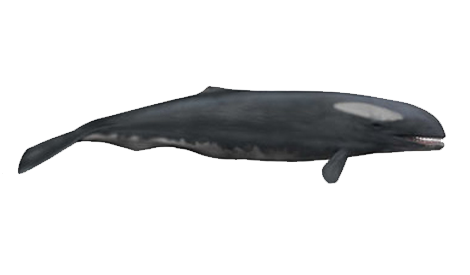
Brygmophyseter shigensis
Conversely, I think that making Brygmophyseter a modified sperm whale is completely appropriate. This animal was a close cousin of the modern sperm whale, and thus would probably look fairly similar.
Decent colors, realistic anatomy, appropriate role within the episode’s story. Pretty decent stuff.
7/10.
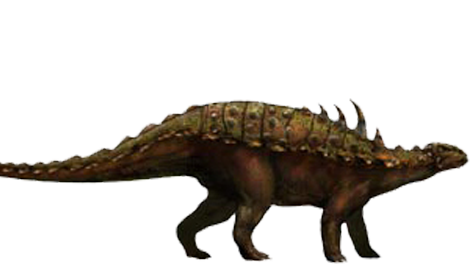
Gastonia burgei
The show’s designers keep doing a really good job with their armored dinosaurs. The Stegosaurus above was one of their best, and Gastonia here is no different.
It certainly helps that Gastonia is known from pretty solid remains, so they had a lot of material to work with. It looks pretty much as it should, and the color scheme is vibrant, but not overdone. Pretty stellar work overall.
9/10.
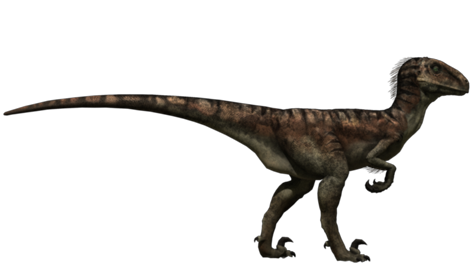
Utahraptor ostrommaysi
Okay, I was willing to be forgiving of the Deinonychus because of the colors, plus the fact that they nailed its skeletal anatomy. This thing doesn’t have either of those advantages.
I can forgive the incorrect skull, Utahraptor‘s skull wasn’t known until nearly a decade after the show came out. What I cannot forgive is the drab, boring color scheme and those AWFUL feathers. If this is all they were going to do to add feathers to their raptors, I’m almost glad they left Deinonychus scaly.
Just awful.
2/10.

Arctodus simus
Wait. They didn’t have the budget to render raptors with proper feathers, but they did have the budget to do an episode all about furry Pleistocene mammals?
Anyways, this is alright. The skull looks a bit off to me, and the legs are too short, but it’s not awful. Y’know, aside from the fact that they gave this bear human eyes for some reason.
6/10.
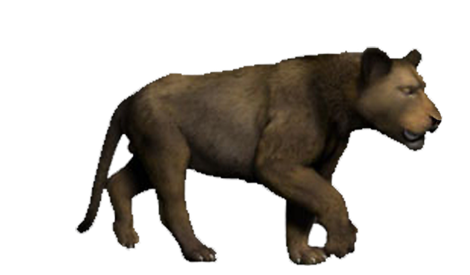
Panthera leo atrox
That sure is a lion.
5/10.

Pachyrhinosaurus canadensis
That is not Pachyrhinosaurus. Even ignoring the erroneous horn, -- which is addressed as speculative within the show -- that is straight-up not the skull of a Pachyrhinosaurus. They just modelled an (admittedly okay-looking) Achelousaurus, and then had the narrator call it Pachyrhinosaurus.
3/10.

Albertosaurus sarcophagus
I don’t even know what to say here. All of the show’s other theropods had something interesting or noteworthy about them, either good or bad. But, this is just every pop-culture Albertosaurus I’ve ever seen.
It certainly is there.
4/10.

Edmontosaurus annectens
This is one of the most completely unremarkable creature designs I’ve ever seen in my life. It’s a single dull color, it has no speculative soft tissue, and its only role in the episode is to be killed and eaten by predators.
This is the closest thing I’ve ever seen to a representation of a Perfectly Normal Beast. There is not a single remarkable thing here.
And it’s a shame, because Edmontosaurus is a very interesting and underrated animal, but here it gets saddled with this halfhearted shrug of a design.
4/10.

Dromaeosaurus albertensis
Yeesh.
This has the advantage of being more anatomically accurate than the Utahraptor and the colors are okay, but those feathers are, again, absolutely appalling.
Topping that off, the narration talks about them communicating with each other via sign language, which is just...dumb. Even as a kid, I thought that was dumb.
2/10.
7 notes
·
View notes
Text
uh hey ask me about my ocs!
Sage: an anxious carnotaurus that taught themselves how to climb trees
Remi: relatively cool and collected irritator. is not to be messed with
Thanos: says the marvel villain was named after him. that’s actually the name of his species tho like seriously. hates being called a nerd.
Maq: a big clumsy acrocanthosaurus that is adamant he’s a cowboy
Poppy: witty, short and sweet armadillosuchus. bites your fingers as a warning. likes cheetos
Cani: a kaprosuchus that lost a good chunk of her tail. stays in the water more than the other crocs
Sebi: a sarcosuchus with way too many dad jokes. appreciates a nice time sliding around in mud
Epan: a trans guy allosaurus and proud of it!! teaching himself how to swim
Sniks: an old amargasaurus. grandpa. sleeps a lot. calls everyone squirt
Connie: another old amargasaurus. grandma, more active than her mate but is perfectly content sitting next to him for hours on end
Avery: a whiny edmontosaurus. can’t be shut up because everyone else is small while he’s a fucking mountain
Cenai: a short tempered pachyrhinosaurus. working on his temperment with the help of Sebi
Bai: a kick ass yutyrannus. the only one who snaps back full force at Thanos
Josie: a lonely concavenator. doesn’t really talk to anyone but also doesn’t seem to mind that
Callie: leader of the dakotaraptor pack. big chatter box
Nebbie: twin sibling to Callie. Judges everything xir sister says
Fabi: unsure if blood related to the pigeon siblings. but doesn’t really care at this point
Dren: a selective mute postosuchus. fairly new to the group and isn’t sure who it’s comfortable being around yet
Hai: a dsungaripterus who feels superior to in the sense that he can have the highest view of things. acts like a brat usually but he sticks up for sage when remi isn’t available
Ron: male troodon who tends to keep closer to the nest and monitor a clutch of eggs he shares with Becky. Pretty friendly as long as you stand 3 feet away from the nest
Becky: female troodon. More snappy around others when close to nest. has midwest soft wife vibe when she isnt feral djskfnhds
Vivi: fat fuck lythronax who genuinely couldn’t care less about whats going on around pix. keeps trying swallow random shit
25 notes
·
View notes
Note
Is it just me, or are the rules of integument inconsistent when it comes to extinct animals? For instance, if a large mammal like a Columbian mammoth lives in a slightly chilly climate, you have to give it a coat of fur. But when there's a dinosaur that's smaller and lives in a similar (if not colder) climate, you have to make it scaly (like Pachyrhinosaurus) simply because we have no evidence it was fuzzy.
I wasn’t aware that there were any “rules of integument”. To be sure, like everything else in biology, not every possibility regarding integument is equally likely. Sharks probably aren’t going to evolve feathers anytime soon. But an animal’s integument is a function of the interplay between a complex suite of factors, including (but not limited to) evolutionary history, environmental conditions, developmental constraints, and preferences of the opposite sex, and we don’t always have enough information to predict the relative contribution and effects of each of these factors.
However, it sounds like you are talking about rules for artistic representations of animals. Well… I wouldn’t say that there are “rules” here either. Animals are depicted in ways deviating from their real or likely appearances all the time, with no real negative repercussions for the artists (as there shouldn’t be). Of course, intent matters. I certainly wouldn’t approve of unfeathered dromaeosaurids in media purporting to represent the latest scientific understanding of dinosaurs.
I do think that artwork of extinct animals needs to be specifically informed by science to be considered paleoart. But even then, it’s misleading to speak of “rules” here. Instead, there is art that is contradicted by contemporary science and art that isn’t. And for paleoart, uncertainty often leaves a lot of wiggle room in which one can depict multiple alternatives all equally uncontradicted (or at least justifiable) by science, which is the point made by All Yesterdays.
In the examples that you mention, we don’t exactly have a complete understanding of integument in either Columbian mammoths or Pachyrhinosaurus. We have direct evidence that Columbian mammoths had hair (as would be expected for a mammal), but we don’t know its density or how it was distributed across their body. We have no direct evidence of Pachyrhinosaurus integument, though we know that it has likely correlates for a keratinous sheath on parts of its face and that at least some other ceratopsids had large patches of scaly skin. In either case, there is hardly enough evidence to claim that you’d “have to” depict Columbian mammoths with thick fur coats or Pachyrhinosaurus entirely lacking filaments for your restorations to be considered scientifically plausible. Mark Witton famously depicted Pachyrhinosaurus with a thick coat of filaments, and last I checked his overall reputation as a scientist and paleoartist remains intact.
But getting to the heart of your point: can the attitudes of some people be inconsistent when evaluating whether an artwork is scientifically informed or not? Absolutely. However, if you can back up your paleoartistic choices with valid evidence and sound reasoning while your critics cannot (and internal consistency is of course an essential component of “sound reasoning”), this should be of little concern. Witton’s case, for example, was no doubt helped by the fact that he was able to explain the scientific reasoning behind his decision in great detail.
5 notes
·
View notes
Text
Nature Trail to Hell Arc IV: Megamart of Darkness (10)
Chapter 10: Bokrug vs. A-Bomb vs. Watt! Ultimate Deathmatch!!!
Despite having only golf clubs, A-Bomb was fearless. A reckless sort of fearlessness that leads one to charge a 25 pound, machine gun toting mass of unadulterated avian fury.
A fearlessness that would only make sense if your opponent was playing right into your hands.
“Bokrug! Look out!”
By the time the last word left my mouth, it was too late. A-Bomb teed off on Bokrug’s jaw, sending the gander flying. The machine gun clattered to the ground, where it shattered into a thousand pieces. All that was left was for A-Bomb to start teeing off on Bokrug’s downed carcass, which he gleefully did. Repeatedly. And it looked very painful, so painful it scared me out of mini golf for life. Even so much as touching a club gives me memories of the poor goose’s gasps of pain.
“Please, my child.” He begged “You may have fallen far, but the kind, innocent boy I once knew is still in there. I can feel it!”
“Really? Because my internet history says otherwise!”
If Bokrug wasn’t getting hit before, now he’d been reduced to the world’s downiest piñata. And yours truly could only watch helplessly as his physical form looked like it was gonna explode into a million bloody pieces any second, too glued to my seat (literally) to do anything. Or was I? Because A-Bomb had only glued the bottom of my seat. If I could only wriggle out of my pants…
Gotta give credit to Bokrug: he held out much longer than I thought he would. But even dinosaurs fall with enough beating, and before long A-Bomb was standing triumphantly over his kill like some African big game hunter. Right as I was able to slip out of my pants. Though when you consider I was wearing my pachyrhinosaurus underwear, the exact same smelly pair I’d been wearing since I’d left camp, this may have made my problem much, much worse.
A-Bomb laughed loud and deep at the sight, his face turning a deep red. This must have gone on for several minutes, him constantly on the verge of chortling his lungs out, myself too strawberry red to move. Then, once he’d spit out enough chuckles to speak again:
“A-are you kidding me?!“He pointed at me like some schoolyard bully. “Of all the dinosaurs you get monogramed on your underwear, you chose the NERD one?!”
I breathed deep. “Pachyrhinosauus is an amazing and criminally underrated member of the ceratopsian clade! In addition, it is woefully underrepresented in museu-”
A-Bomb thought that was a regular knee slapper.
“Kid, everyone knows the only reason they throw Pachyrhinosaurus in museums is so they can reach their diversity quotas! Yy-you are such a pathetic NERD!” Another fit of laughter later, he added “I-I can’t kill you like this!”
He snapped his fingers, summoning a legion of brown bagger clones armed with those dumb laser scanners to circle us.
“How about this? For making me laugh, I’ll let you escape! Heck, I’ll throw in a 30 second head start, free of charge!”
The Brown Baggers joined their master’s jeering, lest they be sent to the unemployment line (AKA Pete’s Slaughterhouse). Speaking of the Master, he pulled a bottle of Crystal Springs Water from his khakis and began chugging like he’d hadn’t drunk in a week, the power coursing through his veins.
I should have run, run like the pathetic wimp I was. But I didn’t. Because at the end of the day, you can steal sacred water from roleplaying geese. You can threaten to turn me into a corporate slave. You can bludgeon a close friend of mine within an inch of his life with and force me to watch. Heck, you can even force me to watch Carney the dinosaur sixty hours straight if you wanna! But nobody, and I mean NOBODY, makes fun of my pachyrhinosaurus underpants and lives to see the next sunrise!
Instead, I dashed for my pants, thirty seconds ticking away fast. Ten seconds in, I was pulling the packet of grow dinosaurs from my pocket. Another ten I got the stupid wrapping off.
Nine…
I remembered what Bokrug had said about the water, how it was enchanted and whatnot.
Eight…
Problem was, I had no idea where the real water was. The only one I knew was the real deal was being held by A-Bomb, and I sure wasn’t getting there.
Seven…
Unless… I looked at the sad water fountain, spurting alone between two shelves. Maybe the water of the sacred spring wasn’t in a bottle at all.
Six…
I concentrated. No going back now. No regrets…
Five…
A red pill rocketed through the air, a glorious, million dollar shot. A million glowing red darts marked themselves on me.
Four…
Three seconds. Four tense, terrible seconds of that pill riding the wind, right to the rim of the water fountain, teetering on the edge until, at last, the Luck of the Tostigs pulled through, and that baby went right down the drain.
Three, two…
Something pushed out from inside the water fountain, something BIG!
One…
Shrapnel exploded from where the water fountain had once been as a giant sponge triceratops burst out, alien style. The beast charged, plowing down brown baggers like they were blades of grass. As for A-Bomb, he didn’t even get a chance to set a stupid expression on his face before he was reduced to a red stain on the tile floor. And from where that water fountain once stood, the sacred spring gushed forth, coating the rest of the little sponge grow capsules, turning them to life-size dinosaurs. Not missing a beat, I hopped on the triceratops, and gave it a little bit of Tostig family advice:
“CHAAAARRRRGGGGGGEEEEEE!”
And boy howdy, did we! With a bellow that shook the foundations of the Wegmart, the triceratops launched fifty employees so high they left little brown bagger shaped holes in the ceiling! Heck, if I hadn’t used my toe claws to lodge myself in its’ skin, I might have been tossed into the next state!. Meanwhile, where the water of the Sacred Sprinng showered on Bokrug, he changed, wings becoming massive muscular arms, a wide sail growing on his back, his face becoming long and crocodilian, feathers became scales. A form I would recognize anywhere: Spinosaurus Aegyptus.
The brown baggers scattered. One dinosaur they could handle, but thirteen? Not a chance! Together, we watched the remaining five or so survivors flee into the stock room as we posed epically on a thousand foot mountain made of their corpses. Any that weren’t fast enough were picked up in Bokrug’s massive jaws and flipped up into the air, only to be swallowed whole like gingerbread pancakes! Our remaining troops, few as there were, flocked to join us.
We’d won.
The words felt weird on my lips, my brain still trying to grasp what just happened.
We’d won.
Yet I couldn’t deny it: somehow, we’d kicked out the most powerful company in Pennsylvania.
“WE’VE WON!”
Bokrug bellowed majestically into the air, his voice ancient and primeval The rest of the birds, dinosaurs, shopping carts, and whoever else was in our slapdash army joined in:
“WE WON! WE WON! WE WON!”
And they carried me out of the store on their wings like I was some kind of rock star.
. . .
That night, we partied. And by partied I mean set out the spoils of our war (snack chips and pretzels, mostly) while everyone stood awkwardly around the punch bowl, not knowing what to say (for guys who wore party hats all the time, LARP geese sure don’t know how to hold a conversation). Bokrug especially seemed interested in going to the little dino’s room and staying there a really long time. As for me, I stared into one of the barbeque fires we’d set around the place for lighting, plotting my next move. Hilda and whatever we’d put in Ms. Hoebag’s body were running the camp like a Siberian Gulag; in the middle of it all was my ticket back to reality, and by extension, my Gameboy Advance.
And, y’know, Mom was probably worried sick about me.
After half an hour of brisk walking, I found the bathroom door. I knocked twice.
“Bokrug, you in there?”
“My apologies,” bellowed the dinosaur, “but it seems as a final act of resistance, the minions of darkness burned all the toilet paper, so that we may never properly use their waste depository facilities.”
Sighing, I shoved some party napkins under the door.
“These do not seem to be the papers I seek. Are you certain these will work?”
“Yeah, I’m sure.”
One flush later, Bokrug barreled out, knocking the door off its’ hinges.
“Thank you.”
“You’re welcome.” I replied, heading in myself.
Bokrug cocked his head to the side, the way birds do when they’re curious.
“And why would you leave paradise? With the waters of the Sacred Springs in our grasp, we shall soon surpass even the empire of Tako Shak in power!”
I shook my head, strategically positioning Mr. Weenie over the dung pit, letting loose. Bullseye. “Bok, I want to stay, but my Mom and Gameboy are at home, and I’m sure as heck my dirty rotten little brother isn’t going to give them company.”
The dinosaur could only stare in awed amazement as I epically exited the loo, piece of toilet paper attached to my shoe. “Long story short, I’m going to summer camp. Wanna join me?”
The dinosaur shook his crocodilian head. “While the idea of devouring communist elementary schoolers does pique my interest, my responsibilities are to my people. I cannot leave them leaderless at such an incredible time.”
“Are you sure?” I asked, feeling a little bit damped down. “There’ll be all the communist turds you can eat.”
“Watterson, you have helped me when I needed it most, but you have your family, and I must care for mine. Surely, you understand?”
And for the first time I thought about how I had left Hilda at summer camp. I wondered how she was holding on now that Shatner and I had left.
But before I could head on my way, the old water lizard had one last surprise in store for me. “However, there is one gift I can give you.”
Holding out a scaly hand, I saw the grow capsules I’d filched off Wegmart, now turned into tiny sponge dinosaurs that galloped across he palm.
“My apologies, they shrunk in the sun.”
You’d think I’d be upset, but I wasn’t worried. Not at all.
. . .
And so we went on our quest: me and twelve grow-sponge saurian mercenaries from hell. We walked along a dirt road for about twelve hours before, as luck would have it, along trundled a Systo delivery truck, the same kind that delivered the crap food to camp. Hitchhiking wasn’t as hard as I thought (having dinosaur claws makes you surprisingly persuasive!), and soon me and the dinosaurs were crammed into a cardboard box in the semitrailer.
And so I sat in the dark, curled up inside a cardboard box meant for Styrofoam containers trying to formulate the master plan to get my body back. And by formulate a master plan I mean trying not to laugh at the Spongeboy jokes that would randomly pop into my head and focus, darn it!
Instead, I found myself drifting to sleep as the truck rolled across the winding backroads leading to fate, to destiny, to the thing that had started this all…
Summer Camp.
(Okay, so maybe I started it all by putting firecrackers in Dad’s cereal, but hey, I wasn’t the one who forced a young, innocent mind to watch Barney the ‘Dinosaur’. ‘Shudder’)
Part IV: MegaMart of Darkness: End
(Author’s Note: To everyone who’s read this far: thank you for hanging with me all this time! It really does mean a lot to me! Anyways, as it stands, I’m not quite happy with the final arc, so I’ll be taking a month’s hiatus to maybe fine-tune it a little bit. Until then, thank you so much for staying with this story, and see you soon!)
0 notes
Text
ARK Park Takes To The Skies In Free DLC Coming Next Month
If the earlier announcement of the Star Trek: Bridge Crew DLC centred around Star Trek: The Next Generation got you excited for new content of a fictional future yet to come, you’ll be delighted to know that the past is getting similar treatment by way of another virtual reality (VR) videogame – or at least the past with a hefty future twist on things.
Since its launch back in March, VRFocus readers have not been shy on social media in telling us how Snail Games’ ARK Park hasn’t quite ticked all the boxes they wanted, whenever we mention the title. Although, it does seem some of that ire may have been misdirected and instead was more aimed at Studio Wildcard’s management of the franchise’s origin title ARK: Survival Evolved. Snail Games for their part have been involved with the series since the end of 2016, and ARK Park – which takes a slightly more educational angle – has received a number of updates over the last few months, including locomotion and visual improvements. The developer even sat down with VRFocus not that long ago, to discuss their thoughts on VR and their future plans regarding content. The first part of that content expansion has today been confirmed, and the great news is that the DLC is going to be free.
Pterosaur Hill is coming to the title at the end of June and is, according to the developer, built around the concept of flight and introducing three new maps. Mountain Lake: Here you’ll be able to take in a bird’s eye viewpoint of proceedings in a hot air balloon, as well as using the more familiar land-based vehicles. Crystal Sky Lift: Which will allow you to “soar through the clouds” and lastly, Aviary. Here you will come face-to-face with the Quetzalcoatlus – the largest prehistoric flying creature – in its nest.
Naturally, there’s been the addition of some more creatures into ARK Park besides the Quetzalcoatlus, and the new species include the Diplodocus, Pachyrhinosaurus, Compsognathus, Therizinosaurus, Gallimimus, Meganeura (giant dragonfly) and the Arthropleaura millipede, the largest known land invertebrate of all time, which could grow to metres in length.
Whilst ARK Park has more educational elements that doesn’t mean its shy on action, as you might have already guessed. So, if you ever wanted to mount a Pterosaur to engage in some dogfighting then we’ve got good news. If you wanted to wave around, say, a samurai sword while doing so? Snail Games have got you covered with a number of new weapons too.
We will bring you more news about how and when the DLC will roll out to PC and console when we hear further. Until that time be sure to check back throughout the day on VRFocus for more VR gaming news.
from VRFocus https://ift.tt/2wZcdPc
0 notes